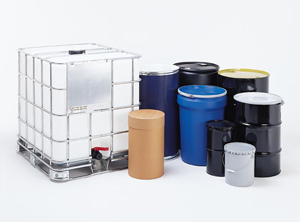RIGID BULK PACKAGING
US market expected to see annual growth of 4% to 2018 / Rebounding chemicals and plastics output will boost demand / Freedonia report
US-demand for rigid bulk packaging is forecast to rise by 4% annually to USD 7.3 bn in 2018, according to a new report from market researcher Freedonia (Cleveland, Ohio / USA; www.freedoniagroup.com).
 Shale oil and gas and reshoring will drive demand for rigid bulk packaging in the US (Photo: Greif) |
The 341-page report, "Rigid Bulk Packaging", says demand will be boosted by resurging manufacturing output and construction activity that is stimulating a rebound in chemicals and plastics production. Gains will also be driven by a growing use of larger, higher value reusable containers which are more cost effective than smaller containers with shorter service lives. However, this growth will be moderated by competition from flexible intermediate bulk containers (FIBCs) in some applications.
Prospects for rigid bulk packaging will also benefit from the increasing competitiveness of US manufacturing including the rising production of shale oil and gas and the trend for reshoring.
Freedonia expects rigid intermediate bulk containers (RIBCs) and material handling containers to see the fastest growth through 2018 because of the cost benefits to be gained over using smaller or single-trip containers. Their advantages include greater reusability and storage and handling efficiency. An increasing emphasis on sustainability and closed-loop supply chains will be another factor in boosting demand growth.
Plastic drums will post above-average gains based on cost and performance advantages over fibre and steel drums. However, any gains will be tempered by competition from RIBCs as well as the entrenched position of steel and fibre drums in certain applications. Drums were the largest rigid bulk packaging product type in value terms in 2013 but will increasingly trail the overall market as they lose out to alternative formats, particularly larger capacity types.
Chemicals and pharmaceuticals, which generate more than half of the demand in the dominant non-durables market, will see the fastest gains. Growth will be fuelled by rising chemical output combined with the increasing healthcare needs of an aging US population and continuing innovations in drug development. Growth in the food and beverage market will be stimulated by population increases, higher consumer spending and favourable prospects for value-added food types such as prepared and assembled meals which tend to contain bulk ingredients shipped in rigid and flexible bulk packaging.
Prospects for rigid bulk packaging will also benefit from the increasing competitiveness of US manufacturing including the rising production of shale oil and gas and the trend for reshoring.
Freedonia expects rigid intermediate bulk containers (RIBCs) and material handling containers to see the fastest growth through 2018 because of the cost benefits to be gained over using smaller or single-trip containers. Their advantages include greater reusability and storage and handling efficiency. An increasing emphasis on sustainability and closed-loop supply chains will be another factor in boosting demand growth.
Plastic drums will post above-average gains based on cost and performance advantages over fibre and steel drums. However, any gains will be tempered by competition from RIBCs as well as the entrenched position of steel and fibre drums in certain applications. Drums were the largest rigid bulk packaging product type in value terms in 2013 but will increasingly trail the overall market as they lose out to alternative formats, particularly larger capacity types.
Chemicals and pharmaceuticals, which generate more than half of the demand in the dominant non-durables market, will see the fastest gains. Growth will be fuelled by rising chemical output combined with the increasing healthcare needs of an aging US population and continuing innovations in drug development. Growth in the food and beverage market will be stimulated by population increases, higher consumer spending and favourable prospects for value-added food types such as prepared and assembled meals which tend to contain bulk ingredients shipped in rigid and flexible bulk packaging.
22.12.2014 Plasteurope.com [230041-0]
Published on 22.12.2014

 German version of this article...
German version of this article...